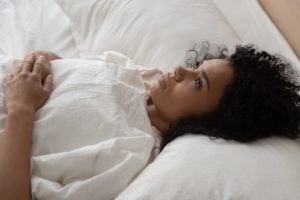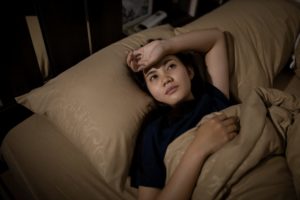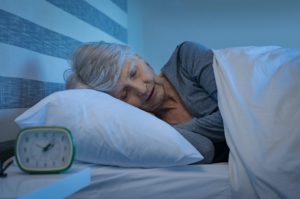What Are the Different Types of Insomnia?
Not all cases of insomnia are identical. People can be affected by insomnia in different ways, and distinguishing between forms of the condition can be useful for both health professionals and people with insomnia.
There are two main types of insomnia: short-term insomnia and chronic insomnia.
Short-Term Insomnia
Also known as acute insomnia or adjustment insomnia, this is a brief episode of difficulty sleeping. Short-term insomnia is often caused by a stressful life event, such as the loss of a loved one, a disconcerting medical diagnosis, a pandemic, rebounding from cessation of a drug or marijuana, or a major job or relationship change.
Acute insomnia lasts for less than three months, and symptoms may fade on their own as time passes and a person copes with the stressful incident that gave rise to their sleeping problems. However, short-term insomnia can be persistent and become chronic insomnia.
Short-term insomnia can affect both children and adults. It is more common in women than in men, and it can arise during pregnancy as well as menopause.
Is Your Disrupted Sleep a Problem?
Answer three questions to understand if you should be concerned.
Chronic Insomnia
Chronic insomnia is a long-term pattern of difficulty sleeping. Insomnia is considered chronic if a person has trouble falling asleep or staying asleep at least three nights per week for three months or longer.
Some people with chronic insomnia have a long history of difficulty sleeping. Inability to get the sleep they need may be persistent or go away and recur with months-long episodes at a time.
Chronic insomnia has many potential causes. Like acute insomnia, it can be tied to stressful situations, but it may also be related to irregular sleep schedules, poor sleep hygiene, persistent nightmares, mental health disorders, underlying physical or neurological problems, medications, a bed partner, and certain other sleep disorders.
Like short-term insomnia, chronic insomnia occurs in people of all ages and has a higher prevalence in women.
Other Ways of Describing Insomnia
While the sleep disorder of insomnia is principally classified as either short-term or chronic, there are other terms that may be used to describe insomnia.
These terms may be used informally or as a way for researchers to better categorize and analyze the different ways that insomnia can be experienced.
Sleep Onset Insomnia
Sleep onset insomnia describes difficulty falling asleep at the beginning of the night, or in the case of shift workers, whenever they attempt to initiate sleep. It is associated with the idea of tossing and turning without actually being able to get to sleep. Most people with sleep onset problems can’t fall asleep even after spending 20-30 minutes in bed.
The inability to fall asleep means that a person with insomnia of this nature has reduced total sleep time and can feel the effects of that lack of sleep the next day.
Sleep Maintenance Insomnia
Sleep maintenance insomnia describes an inability to stay asleep through the night. Most often, this means waking up at least once during the night and struggling to get back to sleep for at least 20-30 minutes.
The fragmented sleep associated with poor sleep maintenance means a decrease in both sleep quantity and quality, creating higher chances of daytime sleepiness or sluggishness.

Terminal Insomnia
Terminal insomnia, also called late insomnia occurs when the sleeper wakes up too early and is not able to fall asleep again. Early morning awakening insomnia typically involves waking up well before a person plans to in the morning.
While some experts view terminal insomnia and early wakings as components of sleep maintenance, others consider it a separate type of insomnia. Inability to get the desired amount of sleep can impair a person’s physical and mental function the next day. Recurrent late insomnia may lead to a loop of excessive daytime sleepiness, falling asleep earlier than desired, and ultimately waking up early in the morning once again.
Mixed Insomnia
Though not a formal term, the descriptor mixed insomnia may be applied to people who have a combination of problems related to sleep onset, sleep maintenance, and early morning awakenings.
In general, the broader term insomnia can be thought of as describing mixed insomnia because it is common for people to have overlapping sleeping problems. In addition, people with insomnia often find that their symptoms can shift over time , making it hard to classify insomnia strictly among the subtypes of onset, maintenance, and early morning awakenings.
Comorbid Insomnia
In the past, sleeping problems were sometimes labeled as comorbid insomnia or secondary insomnia. This meant that insomnia was believed to arise as a result of another condition such as anxiety, depression, sleep apnea, or gastroesophageal reflux disease (GERD).
Contemporary research has generated a deeper understanding of insomnia that recognizes that sleeping problems often have a bidirectional relationship with other health issues. For example, while anxiety may contribute to insomnia, insomnia may trigger or exacerbate anxiety as well. Furthermore, insomnia triggered by another condition does not always go away even after that underlying issue is resolved.
Because of the complexity of these relationships, it becomes difficult to classify insomnia as strictly comorbid or secondary. For these reasons, insomnia classification systems used in sleep medicine have moved away from this terminology and toward a broader understanding of insomnia .
Future Research About Types of Insomnia
Insomnia can manifest in diverse ways, and researchers are working to further identify how causes, symptoms, health consequences, and treatments may be different among distinct subtypes. For instance, some studies have attempted to connect variations of insomnia to a person’s life and health history and to a host of other individual variables .
In the future, it is possible that continued investigation along these lines may sharpen our understanding of insomnia and expand the ability to optimize treatment for any given patient.

Still have questions? Ask our community!
Join our Sleep Care Community — a trusted hub of sleep health professionals, product specialists, and people just like you. Whether you need expert sleep advice for your insomnia or you’re searching for the perfect mattress, we’ve got you covered. Get personalized guidance from the experts who know sleep best.
References
8 Sources
-
Zhang, B., & Wing, Y. K. (2006). Sex differences in insomnia: a meta-analysis. Sleep, 29(1), 85–93.
https://academic.oup.com/sleep/article-lookup/doi/10.1093/sleep/29.1.85 -
Silvestri, R., & Aricò, I. (2019). Sleep disorders in pregnancy. Sleep science (Sao Paulo, Brazil), 12(3), 232–239.
https://pubmed.ncbi.nlm.nih.gov/31890101/ -
Bjorøy, I., Jørgensen, V. A., Pallesen, S., & Bjorvatn, B. (2020). The prevalence of insomnia subtypes in relation to demographic characteristics, anxiety, depression, alcohol consumption and use of hypnotics. Frontiers in Psychology, 11, 527.
https://pubmed.ncbi.nlm.nih.gov/32265811/ -
Hohagen, F., Käppler, C., Schramm, E., Riemann, D., Weyerer, S., & Berger, M. (1994). Sleep onset insomnia, sleep maintaining insomnia and insomnia with early morning awakening–temporal stability of subtypes in a longitudinal study on general practice attenders. Sleep, 17(6), 551–554.
https://pubmed.ncbi.nlm.nih.gov/7809569/ -
Neckelmann, D., Mykletun, A., & Dahl, A. A. (2007). Chronic insomnia as a risk factor for developing anxiety and depression. Sleep, 30(7), 873–880.
https://pubmed.ncbi.nlm.nih.gov/17682658/ -
Sateia M. J. (2014). International classification of sleep disorders-third edition: highlights and modifications. Chest, 146(5), 1387–1394.
https://linkinghub.elsevier.com/retrieve/pii/S0012369215524070 -
Blanken, T. F., Benjamins, J. S., Borsboom, D., Vermunt, J. K., Paquola, C., Ramautar, J., Dekker, K., Stoffers, D., Wassing, R., Wei, Y., & Van Someren, E. (2019). Insomnia disorder subtypes derived from life history and traits of affect and personality. The lancet. Psychiatry, 6(2), 151–163.
https://linkinghub.elsevier.com/retrieve/pii/S2215036618304644 -
Benjamins, J. S., Migliorati, F., Dekker, K., Wassing, R., Moens, S., Blanken, T. F., Te Lindert, B., Sjauw Mook, J., & Van Someren, E. (2017). Insomnia heterogeneity: Characteristics to consider for data-driven multivariate subtyping. Sleep medicine reviews, 36, 71–81.
https://linkinghub.elsevier.com/retrieve/pii/S1087079216301289























